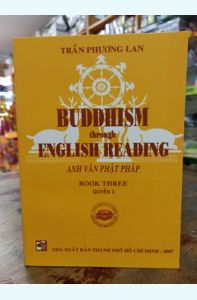ANH VĂN PHẬT PHÁP - Quyển 3
EDITOR'S INTRODUCTION
Dear Brothers and Sisters –in the Dhamma,
Dear Friends –in the-Dhamma,
This is book one of my teaching material for a complete course at the Vietnam Buddhist Academy, formely named the Vietnam Institute of Advanced Buddhist Studies in Ho Chi Minh City. The book containing 12 lessons, a number of supplementary readings and dialogues, and 3 conditional chapters is intended for the first year students. It may also serve as a self-study book for intermediate students of English who wish to learn Buddhist texts and a basic Buddhist technical vocabulary Through English reading.
This teaching material aims to provide Buddhist students with lessons on the Buddha's fundamental teachings and at the same time it attemps to help them to develop their five language skills: listening, speaking, reading, writing and translating.
Since the students are led by gradual steps in learning the lessons, each lesson plan is arranged in 5 parts:
I. Pronounciation
II. Vocabulary
III. Comprehension Questions
IV. Translation into Vietnamese& into English
V. Grammar Review
I. Pronounciation: The first step in learning any lesson is to practise the pronounciation of the sounds and words introduced in each text. The grouping of words into sound columns helps you to practise reading aloud each sound, especially each pair of similar sounds (minimal pair) such as [i:], [I], ..[s], [z], etc…, each word and each column carefully and repeatedly before reading sentence by sentence, paragraph by paragraph several times.
II. Vocabulary: Technical vocabulary plays a very important part in learning Buddhist texts. But a large number of Buddhist technical words and expressions are entirely new to the intermediate students of English. They often find it hard to learn the terms partly because they are not accustomed to reading Englih book on Buddhism and partly because their common English vocabulary is poor.
1. The most important thing is that you need to know the basic and usual meaning of the words and expresions used in the text before coming to their figurative orcontextual meaning.
2. Synonyms, Antonyms and words og the same root (familly) including suffixes and prefixes are always helpful because they centre around the same subject.
3. While learning the vocabulary, you are show how technical terms are used in various examples given by your teacher. Follow those examples and buid sentences of your own, using the words and expressions you have learned carefully.
4. You are encouraged to memorise some sentences from each paragraph in the reading, particularly, some well-know quotations or the Dhammapada Verses, the Buddha's basic teachings, which contain basic Buddhist technical terms.
III. Comprehension questions: Most of the questions can be answered directly from the reading. Practise asking the questions and making answer of your own after studiyng the text carefully. Have a classmate of yours answer a number of questions and then change the role. You can use the exact words and expressions of the text, but try to make your answer as simple as possible since many passages are written in formal or literary style, a style which is not common in spoken English. You can write your answer on the board and correct your mistakes with the help of some advanced students
IV. Translation:
1) Translation into Vietnamese: Once you have studied the text and the vocabulary carefully, you can translate each sentence and each paragraph easily with the help of chapter IV, which supplies you with lists of English – vietnamese equivalents
2) Translation into English: Every now and then , I Would like you to put into practice a number of words and expressions and sentence patterns that you have learnt from your lesson or grammar. Try to do the translation of your own carefully.
V. Grammar Review: Only a number of grammatical points concerning some sentence structures in the text are treated here because of time limitation in class.
While doing some revision of various kinds of clauses and sentences, the students learn how to make simple sentences , and then to combine them into compound and complex ones by using conjuntions and relative pronouns or adverbs. Besides, some forms and uses of the gerung, the infinitive, the participles, the reported speech, the formal or literary style are explained in brief.
VI. ChapterIII: This chapter consists of five supplementary lessons: some information about the VN Institute of Advanced Buddhist Studies (the form name of the VN Buddhist Academy in HCM City) and the VN Buddhist Risearch Institute, a number of dialogues that help you to talk about your school, your class, your monastic life and act out various roles at your English speaking club or at home when possible, a short introduction to Dhammapada, and lastly, an article by a modern Buddhist scholar, Professor Dhirasekera about the Buddhist concept of Beauty, which contains some verses from the Theragàthà (The Psalms of the Brethren), a book of the Original Pàli Canon. The Vietnamese metrical translation of the verses will somehow help you to practise translating English poems into Vietnamese ones
VII. Chapter IV, V, VI:
1) Chapter IVsupplies lists of English – Vietnamese Equivalents
2) Chapter Vgives answers to the questions based on the texts
3) Chapter VIgives the Vietnamese translation of the texts and the English translation of some sentences based on the lessons
ACKNOWLEDGEMENTS
- I am greatly indebted to the autors and translators listed in the bibliography for they invaluable references.
- I wish to express my deep gratitude to the Leadership of the VN Buddhist Academy in HCM City for their approval of this teaching plan and their support to my achievement.
- I would like to send my high appreciation to the Brothers and Sisters (of course III) who have assisted me in typing the manuscripts and correcting the proof with great care, especially Brother Thích Tâm Khanh, Sisters Thích Nữ Huệ Hương, Thích Nữ Diệu Thuận, Thích Nữ Nguyên Đoan and miss Trần Thì Kim Phượng.
- And I am also very grateful to many others who have contributed in various ways to the publication of the present book for the benefit of many people.
In spite of our point efforts , there many remain a number of weaknesses in this book. We sincerely hope to receive valuable suggestions from any professors and scholars who will kindly help us to improve our work for the next edition.
May the Triple Gem bless our meritorous deeds
May all of us be well and happy!



















_0gue-gj.jpg?t=1686792914)















